OBD2 Fuel Trim Monitor
2017 Smog Update Class
OBD2 Fuel Trim Monitor
Some of the Images are from your Smog License Update Class manual by AGT Training
I know coming from work and setting in a class lecture can be hard but I appreciate your effort.
This is the lecture from class repeated just encase you came in late or dose off LOL.
OBD2 Fuel Trim Monitor: O2 Sensor Operation
OBD2 Fuel Trim Monitor:
When we talk about fuel, trim we have to keep in mind that the O2 sensor is the heart of the fuel control system. The O2 sensors will be the indicator or as one of my students has said, is the snitch of the air/fuel mixture.
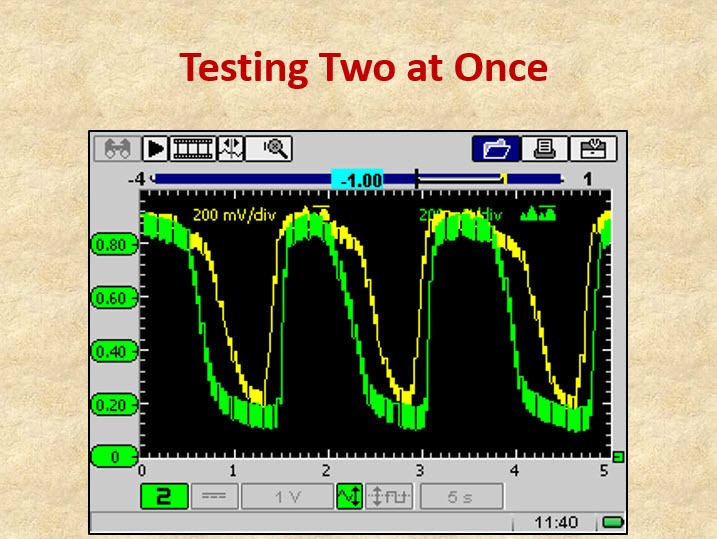
IMAGINE BY AGT CLASS TRAINING MANUAL
The O2 sensor will notify the PCM "Power Train Control Module" if the exhaust is rich "low O2 content" or lean "High O2 content.
It does this by generating a voltage from 100mv to 900mv, anything 500mv or higher indicates a rich condition while 450mv and below indicates a lean condition.
The PCM response should add fuel "increase injector pulse width" or subtract fuel "decrease injector pulse width" to help balance the air/fuel mixture.
For example, if the O2 sensor indicates a rich condition "high O2 sensor voltage the PCM should respond with a lean command, by closing the injector pulse width.
If the O2 sensor indicates a lean condition "Low O2 sensor voltage the PCM should respond with a rich command, by increasing the injector pulse width.
This becomes's a problem when the PCM is either adding or subtracting fuel at the wrong time, causing either a driveability problem or gas mileage issue.
A properly operating O2 sensor in a close loop should switch from 100mv to 900mv and average 450 millivolts.
OBD2 Fuel Trim Monitor: Short Term Fuel Trim Operation
OBD2 Fuel Trim Monitor
Short Term Fuel Trim
The PCM uses the STFT "Short Term Fuel Trim" to help switch the O2 sensor from rich to lean and back again. The job of the STFT Is to keep the O2 sensor switching above and below 450 millivolts by increasing and decreasing the injector pulse width.
When the O2 sensor reads a rich indication, the voltage readings are over 450 millivolts the short term fuel trim should shift negative "decreasing fuel delivery."
This shift in voltage will continue until the O2 sensor readings drop below 450 millivolts.
Also if the O2 sensor reads lean the voltage readings are under 450 millivolts the short term fuel trim shifts up "adding fuel" in small increments to drive the O2 sensor above 450 millivolts.
The normal STFT "short term fuel trim" range is from up to 10% for a rich command, and down to -10% to cause a lean command.
Newer vehicles will have a tighter range +/- 5% but as the mileage increases the engine wears the tolerance increase to +/- 10%.
Keep in mind the STFT job is to keep the O2 sensor switching from 100mv to 900mv and averaging 450mv.
Also short term fuel trim is responsible for monitoring the oxygen sensor and making an immediate shift to balance the air/fuel mixture. The STFT has a short memory, meaning when the key is the turn off the memory is lost.
STFT only works in a close-loop; this is when the PCM is responding to the O2 sensor signal, and the engine is at operating temperature.
Open Loop is when the PCM ignores the O2 sensor, and the PCM operates with default values, this is usually on a cold engine, wide open throttle, deceleration or if the check engine light comes.
OBD2 Fuel Trim Monitor: Long Term Fuel Trim Operation
OBD2 Fuel Trim Monitor
Long Term Fuel Trim
Long term fuel trim is monitoring at all times, but in most cases, it will only adjusting during the close loop. The long term fuel trim memory is not lost like the short term fuel trim.
LTFT memory is retained even when the key is turn off and restarted the memory is retained. The LTFT is constantly adjusting base off the information from the STFT in a particular load cell.
If you are diagnosing a vehicle you should be watching the LTFT "Long Term Fuel Trim" not only the STFT and O2 sensor; LTFT is and overall adjustment to balance the air/fuel mixture.
The job of the long term fuel trim is to watch the STFT and keep it switching above and below 0% which is the norm, plus or minus 10%.
Here is an example, if the STFT is +15%, which is out of range of +/- 10% from 0%. The LTFT "Long Term Fuel Trim" will increase towards the positive side of 0% to help pull the STFT back down towards 0%.
OBD2 Fuel Trim Monitor
Remember if the STFT achieves a positive and negative varying reading again the O2 sensor will start switching and balancing the air/fuel mixture, at least that's what it seems like to the naked eye.
Also, I would like you to know the STFT and LTFT are affecting the injector pulse width duration. These numbers are either added or subtracted together.
For example, if the STFT is +15 and the LTFT is +10% the total pulse width is increase by 25% "more fuel" rich command.
This method also works in reverse also, -15% STFT and the LTFT –10% the injector pulse width is reduced by 25% "less fuel" lean command.
Keep this in mind a positive number the PCM is trying to add fuel which is called a rich command. A minus number the PCM is trying to subtract fuel which is called a lean command.
Usually the condition "O2 sensor reading" is the opposite of the command "the PCM correction".
OBD2 Fuel Trim Monitor: Both STFT and LTFT are Max Out - What is the Result
Both the STFT and the LTFT have a maximum and minimum tolerance when the tolerances are reached for a certain amount of time the check Engine light will come on. The tolerance is usually +/-25% from 0%.
All manufacturers have different limits for their fuel tolerance.
Here is another example if either the STFT, LTFT both read plus or negative 25% the check engine light will illuminate.
This would be a maxima adjustment of 50% increase in the injector pulse width in an attempt to correct a problem.
The monitor will fail the circuit and turn on the check engine light; this is when you have to find the cause of the problem.
The most common code is P0171 O2 sensor lean, most people will replace the O2 sensor without even checking the circuit, can you say code readers and part change experts.
There are a lot of people who but a code reader on the vehicle read the code and change the part without checking anything. Hopefully, after you finish this class, it will not be you.
OBD2 Fuel Trim Monitor: Common Codes P0171 P0172 P0173 P0174
OBD2 Fuel Trim Monitor
PO171, P0172, P0173, and P0174 are common fuel imbalance issues it's up to the technician to locate the cause of the problem.
Here is an example a vacuum leak from an intake manifold gasket, the O2 sensor would read a low voltage "less than .450mv" indicating a lean condition, and the check engine light comes on P0171.
Remember look at the STFT, a reading of 15% would indicate a command to add fuel if the reading stays out of tolerance for a set time the check engine light may come on indicating a failed monitor.
A reading of "15%" means the PCM is trying to balance the air/fuel ratio by increasing the injector on time by 15% "adding fuel" rich command.
Usually, when the air/fuel mixture goes out of balance it can relate to a mechanical problem or any sensor, this what makes diagnosing so enjoyable.
OBD2 Fuel Trim Monitor: Ignition Misfire
IGNITION MISFIRE:
A simple ignition misfire from a plug, spark plug wire can also send the STFT and LTFT on the positive side.
Think about this a misfire does not burn fuel or air, but the O2 sensor only reads O2 so any unburnt O2 going pass the sensor will be intrepid as a lean condition, and the PCM will respond by adding fuel.
So always check the basic first before diving into the computer circuit.
Now let's look at the AGT Training manual on page 1-65
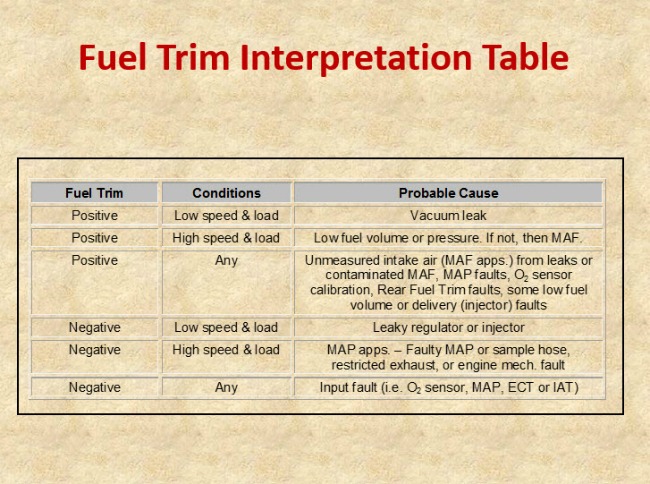
IMAGINE BY AGT CLASS TRAINING MANUAL
The manual is giving trim fuel interpretation of a vacuum leak positive fuel trim at low speed and load, here is my interpretation.
If a vehicle has a high STFT at idle and the readings get better at 2500 RPM's in the park or neutral this is a good indication of a vacuum leak.
The manual also states if a vehicle has a positive fuel trim at high speed and load it could indicate a fuel volume or pressure problem.
I once read an article saying you can diagnose a bad fuel pump with a scan tool; my first reaction was yeah right.
Until one day I was diagnosing a customer's car with a lack of power issue and while I was test driving the car of the client, I had the scan tool connected to it, not thinking about the article.
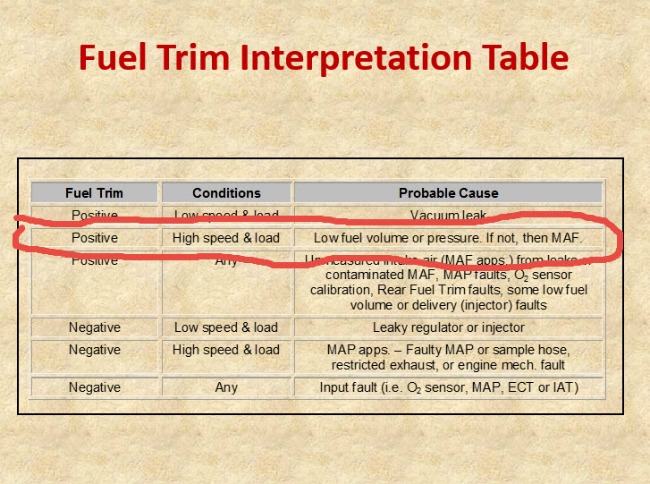
IMAGINE BY AGT CLASS TRAINING MANUAL
As the vehicle started to lose power I notice the Block Learn Multiplier "now call LTFT" started to increase.
Which could indicate a lack of fuel, so I went to the shop and check fuel pressure, then I remember the article I have read earlier.
The fuel pressure confirms the high block learn numbers "Now call LTFT" the fuel pump was bad; live and learn.
High fuel trim with a lack of power does not always indicate a bad fuel delivery system, have you ever drove a vehicle that had a dirty or defective MAF sensor.
It feels just like a car running out of fuel.
A clue would be high STFT and LTFT at idle and cruise with low Volumetric efficiency.
The slide also talks about negative fuel trim, remember this is an indication that the PCM is trying to subtract fuel for a rich condition.
The example shows a leaky fuel injector or regulator which can cause this condition; many GM spider injectors have this issue along with a multi misfire code in some cases.
OBD2 Fuel Trim Monitor: Locating a Vacuum Leak
Vacuum Leaks
There are different ways a vehicle can have a vacuum leak; some one could have just tune their car and install the wrong PCV, and the is mostly open at the wrong time.
The brake booster can be defective; purge valve stuck open with no vapors in the canister would cause a lean condition.
A leaking EGR valve that isn't seating completely intake-manifold gaskets and a poor signal from a sensor.
All of these conditions can and will cause STFT and LTFT to increase.
Someone "Jose" show me this trick a long time ago while checking for the location of a vacuum leak, while observing the STFT readings, use the propane to find the leak once the propane hits the vacuum leak the STFT will start to come down, you just found your problem.
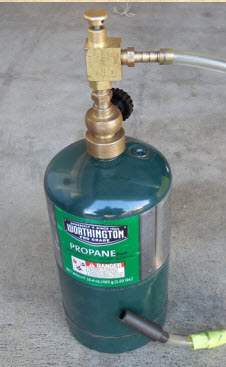
IMAGINE BY AGT CLASS TRAINING MANUAL
The AGT Training manual smog update training class are showing you the freeze frame from a vehicle with an STFT and LTFT problem.
The manual is also showing something they else they found on slide 93 and 92 from the update class manual by AGT Training.
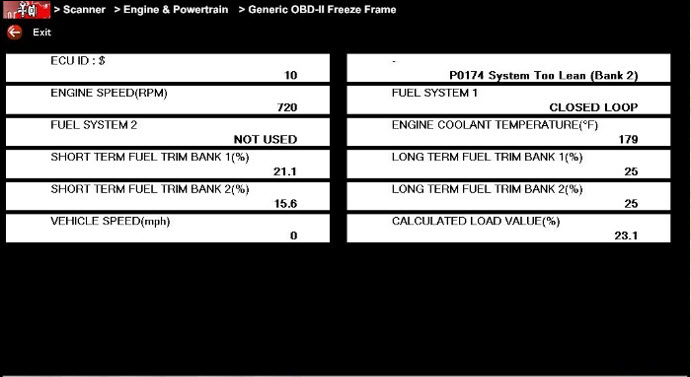
IMAGINE BY AGT CLASS TRAINING MANUAL
OBD2 Fuel Trim Monitor: High CO Rich Condition
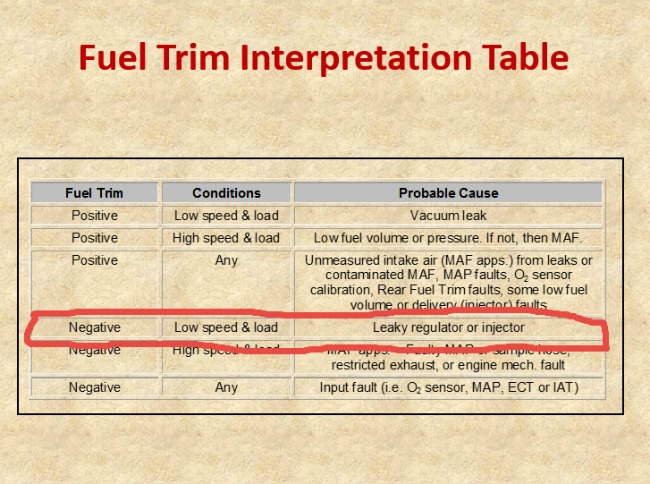
IMAGINE BY AGT CLASS TRAINING MANUAL
High CO "Carbon Monoxide" always indicates a rich condition in the slide above you see fuel trim is negative meaning the PCM is trying to reduce the fuel to the combustion chamber. If you see anything from a -15 to -25 on your scan tool you need to find the source of unwanted fuel being drawn into the combustion chamber and causing a rich condition.
In this example the fuel injectors are leaking fuel, the pintle is not seating, and the fuel is leaking out into the combustion chamber.
OBD2 Fuel Trim Monitor: Rear O2 Sensor Operation
REAR O2 SENSOR
I recently diagnose a 1994 Toyota that failed smog check, with high emissions I have to tell you it was giving me a hard time.
Yes the rear, not the front, I have seen this problem in newer cars but not this old of a vehicle.
The job of the rear O2 sensor is to keep the front O2 sensor switching below and above 450mv.
This sensor was dead when I added propane to the induction system the rear sensor did not move; that's correct even the rear sensor should go up 'indicating a rich condition" when you flood the induction system with propane.
My diagnoses was a defective rear O2 sensor, smog the car it pass and the customer was happy.
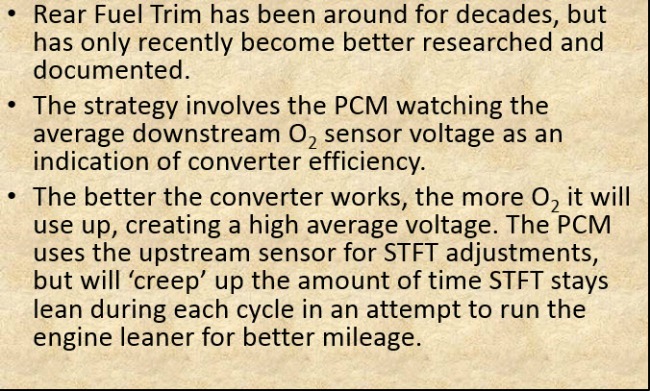
IMAGINE BY AGT CLASS TRAINING MANUAL
CLASS SCHEDULES
Emission Control 1:
B.A.R. Smog Check
Inspector Level 1
(Inspector "Smog" License):
Engine Fundamentals
8am - 12:15 pm
Summer Class
7/5/2022 -8/5/2022
Class # 799065
Emission Control 2:
B.A.R. Smog Check
Inspector Level 2
(Inspector "Smog" License):
Rules and Regulations
8am - 12:15 pm
Summer Classes
7/5/2022 - 8/5/2022
Class # 799067
Engine Performance 1:
8am - 12: 15 pm
Date: TBD
Class # 799069
Engine Performance 2:
B.A.R. Specified Diagnostic
and Repair Training
(Repair "Smog" License)
Time: TBD
Date: TBD
Class # 799071
Emission Control 1
(Inspector "Smog" License):
5:00pm - 8:45 pm
Date: TBD
Class # 799065
Emission Control 2:
(Inspector "Smog" License):
5:00pm - 8:45 pm
Date: TBD
Class # 799065
Exhaust Emissions (Update Class):
5:30 pm - 8:45 pm
Tuesday nights:
Dates: coming soon
Class # 796070